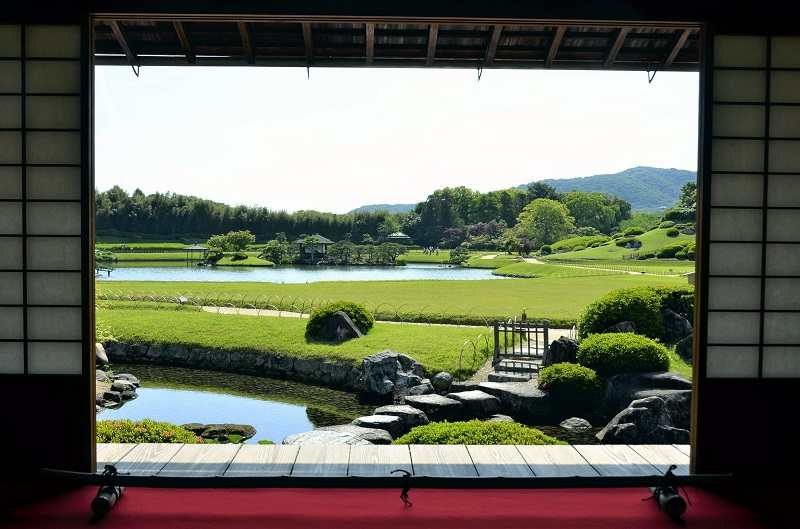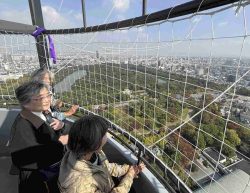
The 6-meter-high Yuishinzan Hill is seen at Okayama Korakuen Garden with Okayama Castle in the back right.
12:52 JST, September 24, 2022
OKAYAMA — Okayama Korakuen Garden is one of the three great gardens of Japan — along with Kairakuen in Mito and Kenrokuen in Kanazawa — and there are ongoing efforts to make it more accessible to the public and preserve its appearance, to ensure it looks as it was when first built.
Korakuen, which spreads out below to Okayama Castle, was built about 300 years ago by a feudal lord of Okayama. The garden has a total area of 144,000 square meters, including 10,000 trees of about 200 species and 19,600 square meters of lawn. Buildings that still retain their elegant appearance are dotted about the garden.
Lord of Okayama Ikeda Tsunamasa created the garden as a place for himself to relax. According to records, his son Tsugumasa established the 6-meter-high Yuishinzan Hill, which is almost the center of the garden, and built waterways and ponds around it. Tsunamasa’s grandson Harumasa converted the nearby fields into lawns.
“As lords changed, the garden was gradually modified. Finally, it became what it is,” said Mika Sakamoto, an official at the Korakuen Garden Office.
Original tree types
After the Tokugawa shogunate period ended, ownership of Korakuen Garden was transferred from the Ikeda family to the Okayama prefectural government in 1884. The garden was severely damaged by floods and World War II, but was restored based on an old document.
However, poor maintenance in the chaotic period during and after the war changed its makeup. The garden became a dense forest of Japanese cedars, camphor trees ginkgo and other trees that were not there when the garden was built.
Currently, a restoration project is underway, and 355 trees have been cut down so far. The garden plans to plant cherries, maples and pines to replace them.
As for the species of trees, experts are considering which to use based on strict criteria created from old records. When planting cherry trees, for example, they plant yamazakura and higanzakura trees instead of someiyoshino, which became popular in the 20th century.
Same view as lords

No modern structures are seen in a view looking eastward from Enyotei.
The most important building in the garden is Enyotei House, the lords’ residence. It was believed to have been completed in 1689. On June 29, 1945, an air raid by the U.S. military burned down the center of Okayama City, destroying Enyotei, the Noh stage and other major buildings. Enyotei was restored in 1960.
“For the restoration, high-quality lumber was gathered from all over Japan,” said Sakamoto.
The view from the east side of the residence has been considered the most important in Korakuen because it is the same as what the lords would have seen. Local ordinances have limited the height of surrounding buildings — modern buildings must not be seen in the field of view from a height of 1.5 meters, or eye level, when looking at the garden from around the center of the east corridor of Enyotei House.
Tourist destination
Okayama Korakuen Garden has always delighted visitors.
Tsunamasa, the founder of Korakuen, built a noh stage in the garden and put on performances for the people. Noh, a type of Japanese theatrical performance, was regarded as a must for samurai. Tsunamasa was not only a Noh lover but also an excellent actor.
His successors also allowed people into the garden on certain days, which was extraordinary at the time.
The number of visitors to Korakuen has decreased to less than a third of what it was before the pandemic. Various efforts are being made to ensure the garden’s popularity as a tourist destination.
Ume plum fruit is harvested every June from the garden’s grove of about 100 trees and processed into wine and jam, which are sold as branded products. Tea leaves are also harvested in the garden and sold under the same brand as Japanese black tea and sencha, a type of Japanese green tea prepared by infusing leaves in hot water.

A staff member shows branded tea leaves harvested in Korakuen.
The tea from Korakuen is a native Japanese variety with a strong aroma that was used before new varieties were developed. Both black tea and sencha sell out quickly due to their popularity.
How to get there

Okayama Korakuen Garden is a 25-minute walk from the east exit of JR Okayama Station. Taking a streetcar, catch one bound for Higashiyama from Okayama-ekimae and get off at Shiroshita, a 10-minute walk from the station. The admission fee is ¥410 for adults, free for high school students and younger, and ¥140 for people 65 and older. Annual passports are also available.
Related Tags
"Features" POPULAR ARTICLE
-

Sanrio to Open Museum in Yamanashi Pref. Dedicated to Founder, Exhibits Include Hello Kitty, Other Characters
-

Autumn Foliage Surrounds Visitors to Tokyo’s Showa Kinen Park
-

My Daughter No Longer Speaks to Me, But I Want to See Her and My Grandchild
-

Kumamoto: Public Bath Refurbished as Library Where You Can Chat, Take Photos
-

Frozen Vegetables: Demand Rises for Convenient, Tasty Domestic Produce
JN ACCESS RANKING
-

Keidanren Chairman Yoshinobu Tsutsui Visits Kashiwazaki-Kariwa Nuclear Power Plant; Inspects New Emergency Safety System
-

Imports of Rare Earths from China Facing Delays, May Be Caused by Deterioration of Japan-China Relations
-

Tokyo Economic Security Forum to Hold Inaugural Meeting Amid Tense Global Environment
-

University of Tokyo Professor Discusses Japanese Economic Security in Interview Ahead of Forum
-

Japan Pulls out of Vietnam Nuclear Project, Complicating Hanoi’s Power Plans


























